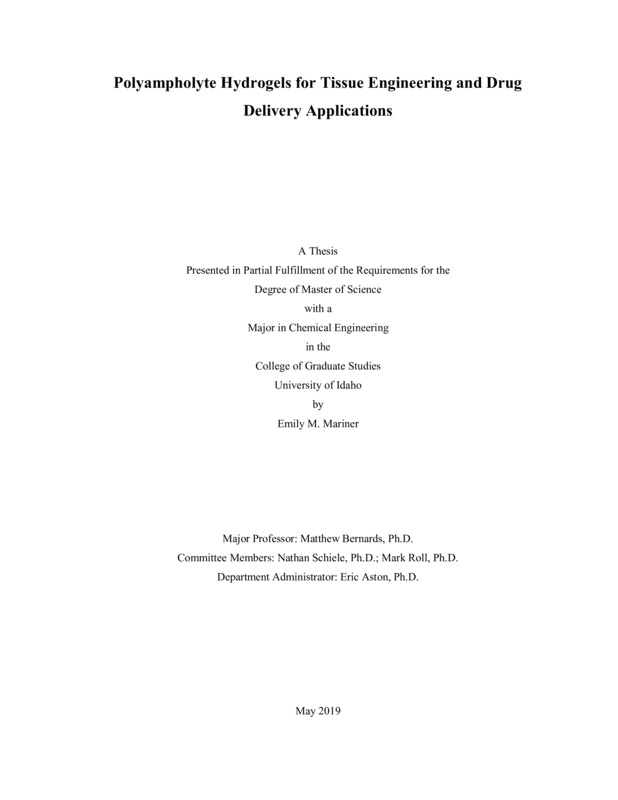Polyampholyte Hydrogels for Tissue Engineering and Drug Delivery Applications
Mariner, Emily. (2019-05). Polyampholyte Hydrogels for Tissue Engineering and Drug Delivery Applications. Theses and Dissertations Collection, University of Idaho Library Digital Collections. https://www.lib.uidaho.edu/digital/etd/items/mariner_idaho_0089n_11604.html
- Title:
- Polyampholyte Hydrogels for Tissue Engineering and Drug Delivery Applications
- Author:
- Mariner, Emily
- Date:
- 2019-05
- Keywords:
- Polyampholytes
- Program:
- Chemical and Materials Science Engineering
- Subject Category:
- Polymer chemistry
- Abstract:
-
Polyampholyte polymers are being investigated for biomedical applications such as drug delivery and tissue engineering. These polymers are composed of equimolar positively and negatively charged monomers and they possess nonfouling properties that reduce the risk of a foreign body response. Nonfouling combined with tunable mechanical and drug release properties make them very suitable for many applications in the biomedical field.
In this work, the mechanical and degradation properties are characterized as a function of cross-linker species. Specifically, we evaluated the influence that the number of ethylene glycol repeat units has on the overall material performance by synthesizing and evaluating hydrogels containing di-, tri-, and tetra-ethylene glycol dimethacrylate cross-linker species. The degradation studies were conducted for over 100 days in Sorenson’s buffer with pH values of 4.5, 7.4, and 9.0 by tracking the swelling behavior and weight change over time. The mechanical properties were evaluated using compression and tensile testing to failure.
Additionally, a piezoelectric droplet on demand generator was designed and constructed to produce polyampholyte microspheres for drug delivery. The microspheres were composed of a 1:1 molar ratio of [2-(acryloyloxy)ethyl] trimethylammonium chloride (TMA, positively charged) and 2-carboxyethyl acrylate (CAA, negatively charged) monomers cross-linked with TEGDMA. Polymerization was initiated using LAP photoinitiator upon droplet ejection. This study evaluated the viability of using these microspheres for releasing vitamin D3 and metanil yellow into biological media. The size and nonfouling properties were also investigated.
In these studies, we found that the cross-linker chain length does influence the mechanical properties and degradation behavior. Droplet generation of nonfouling polyampholyte microspheres was successful; however, there was no success with long-term drug release of vitamin D3 or metanil yellow. Polyampholytes still show promise for use in biomedical applications, though the droplet generator would need some modifications to use these microspheres for drug delivery.
- Description:
- masters, M.Engr., Chemical and Materials Science Engineering -- University of Idaho - College of Graduate Studies, 2019-05
- Major Professor:
- Bernards, Matthew T
- Committee:
- Schiele, Nathan; Roll, Mark
- Defense Date:
- 2019-05
- Identifier:
- Mariner_idaho_0089N_11604
- Type:
- Text
- Format Original:
- Format:
- application/pdf
- Rights:
- In Copyright - Educational Use Permitted. For more information, please contact University of Idaho Library Special Collections and Archives Department at libspec@uidaho.edu.
- Standardized Rights:
- http://rightsstatements.org/vocab/InC-EDU/1.0/

